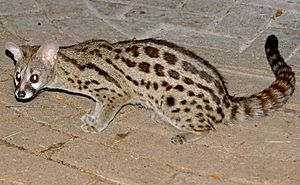Cape genet facts for kids
Quick facts for kids Cape genet |
|
|---|---|
 |
|
| Conservation status | |
| Scientific classification | |
| Genus: |
Genetta
|
| Species: |
tigrina
|
The Cape genet (Genetta tigrina) is a fascinating animal that looks a bit like a cat. It is also known as the South African large-spotted genet. This unique creature lives only in South Africa.
Cape genets are mostly active at night, which means they are nocturnal. They also spend a lot of time in trees, making them arboreal animals. They prefer to live near rivers in forests, but they try to avoid very wet, swampy areas. The Cape genet is not considered endangered; its conservation status is "Least Concern," meaning there are still plenty of them in the wild.
Contents
What is a Cape Genet?
A Cape genet is a type of genet, which belongs to the Viverridae family. This family includes other small, cat-like mammals. Genets are known for their long bodies, short legs, and long tails. They are very agile and good at climbing.
Appearance of the Cape Genet
Cape genets have beautiful spotted coats. Their fur is usually a light grey or yellowish-brown color. They have many dark spots all over their bodies. These spots often join together to form stripes on their necks and backs. Their tails are long and bushy, with dark rings.
They have large eyes and pointed ears, which help them see and hear well in the dark. An adult Cape genet can grow to be about 45 to 60 centimeters (18 to 24 inches) long. Their tails can be almost as long as their bodies!
Where Do Cape Genets Live?
The Cape genet is found only in the southern and eastern parts of South Africa. They live in a variety of habitats. These include forests, woodlands, and even fynbos, which is a type of shrubland unique to South Africa.
They especially like areas near rivers and streams. These "riparian zones" provide plenty of trees for climbing and hunting. They need places with good cover, like dense bushes or trees, to hide from predators and find food.
What Do Cape Genets Eat?
Cape genets are omnivores, meaning they eat both plants and animals. Their diet is quite varied. They are skilled hunters and mostly eat small animals.
They often hunt small rodents like mice and rats. They also catch birds, insects, and even reptiles. Sometimes, they will eat fruits and berries. Their sharp claws and teeth help them catch and eat their prey.
How Do Cape Genets Behave?
As nocturnal animals, Cape genets spend their days resting in trees or hidden dens. They come out at night to hunt for food. They are mostly solitary animals, meaning they prefer to live alone.
They are excellent climbers and spend a lot of time in trees. Their long tails help them balance as they move through branches. They use their strong sense of smell and hearing to find prey in the dark.
Female genets usually give birth to one to three young ones at a time. The babies are born blind and helpless. Their mother takes care of them until they are old enough to hunt on their own.
Conservation Status
The Cape genet is listed as a species of "Least Concern" by the International Union for Conservation of Nature (IUCN). This means that their populations are stable. They are not currently facing a high risk of extinction.
However, like many wild animals, they can be affected by habitat loss. Protecting their forest and river habitats is important. This helps ensure that Cape genets continue to thrive in South Africa.
Images for kids
See also
 In Spanish: Jineta tigrina para niños
In Spanish: Jineta tigrina para niños




